December 17 is the last day for the approval of the vacation schedule, because it must be signed by the head of the organization no later than two weeks before the calendar year (Article 123 of the Labor Code of the Russian Federation). There is very little time left to have time to compose it correctly.
Organize the scheduling
The graph reflects information on the distribution of annual paid vacations of employees of the organization for the calendar year by months. Developing a vacation schedule takes a lot of time for the personnel department. It is possible to organize the work on collecting and processing the necessary data in different ways. It is convenient for someone to entrust this to a separate HR specialist who will be busy with the “from and to” schedule. It is more convenient for others to distribute responsibilities: assign one or more structural divisions to each employee of the personnel department.
Drawing up a schedule is a responsible matter, many things need to be taken into account in it: the wishes of employees about vacation dates, the needs of the production process, and the norms of labor legislation. It is advisable to reflect the procedure for developing a schedule, the conditions and rules for granting holidays in the local regulations of the organization (internal labor regulations or a collective agreement). In the instructions for personnel records management, you can describe in detail the procedure for filling out the vacation schedule both at the stage of its creation and in the process of maintaining it during the year. If the procedure for developing a vacation schedule is not prescribed in the local regulations of the organization, it is worth starting its preparation by issuing an order in which you need to specify:
- who is responsible for preparing the vacation schedule (the schedule is signed by the head of the personnel service, but the preparation work can be carried out by a personnel specialist);
- within what time period employees must submit their wishes regarding vacations;
- the deadline by which the heads of structural divisions must coordinate the wishes of employees with the production plans of departments;
- the deadline by which the draft schedule must be submitted for approval to the manager.
The vacation schedule should take into account the peculiarities of the organization's production process, ensure its continuity and the interchangeability of employees. The Labor Code gives every opportunity for this, because the order in which vacations are granted is determined by the employer (Article 123 of the Labor Code of the Russian Federation). In order to avoid disputes and disagreements with employees, the procedure for determining the order of vacations should be prescribed in a local regulatory act (PVTR or a collective agreement). So, for example, it should provide that the heads of structural units should not be on vacation at the same time as their deputies. In some organizations, it may be established that annual leave is provided to employees only in certain months (for example, in an educational institution, providing leave in the autumn-winter-spring period will negatively affect the learning process). A situation is possible when it is beneficial for the employer to send a large group of employees on vacation at the same time (for example, a manufacturer of window structures, due to low demand for products, can schedule vacations for all employees of the production department for the period from January 12 to February 8). For most organizations, the best option is to evenly distribute employee vacations throughout the year.
The draft vacation schedule is prepared by the personnel department of the organization. It is most convenient to do this using a modified vacation schedule form (Appendix 1). First of all, it is necessary to analyze the “vacation stories” and determine how many days of vacation each employee is entitled to expect next year, whether there are employees of privileged categories who enjoy benefits when establishing the order of vacations. After that, data on employees is transferred to the heads of structural divisions, who must find out the wishes of employees about the time of going on vacation and dividing the vacation into parts, and also coordinate these wishes with the plans of the unit for the year, setting the optimal order of vacations. Based on the projects of structural divisions, the personnel department prepares a consolidated vacation schedule for the organization and submits it for approval to the head.
By the way! To accurately schedule vacations, use the online service "My Business". Also, the service will help you automatically calculate advances, salaries, benefits, compensations, taking into account all legal requirements. Carrying out step-by-step actions, you will not make mistakes and you will not have to pay fines. Reporting is generated step by step based on your data and is controlled at every step. Compiled reports can be submitted online. Without special knowledge and skills, you can keep even the most complex personnel records. Document templates contain tips for filling out, key forms are generated automatically. In your personal account you will find all the necessary instructions and tips. You can get free access to the service right now at the link.
What to include in the schedule
Your vacation schedule should include:
- annual basic paid leave;
- annual additional paid leave;
- vacation that was not used by the employee during the current year and was carried over to the next year.
The duration of the annual basic paid leave, as a rule, is 28 calendar days (Article 115 of the Labor Code of the Russian Federation). For some categories of employees, the legislation provides for holidays of longer duration - extended basic leave. These categories include in particular:
- workers under the age of 18. They are entitled to a vacation of 31 calendar days (Article 267 of the Labor Code of the Russian Federation);
- invalids. They are given a vacation of at least 30 calendar days (Article 23 of the Federal Law of November 24, 1995 No. 181-FZ “On the Social Protection of Disabled Persons in the Russian Federation”);
- pedagogical workers. The duration of their leave depends on the position and type of educational institution and ranges from 42 to 56 calendar days (Article 334 of the Labor Code of the Russian Federation; Decree of the Government of the Russian Federation of October 1, 2002 No. 724 “On the duration of the annual basic paid leave provided to teaching staff”);
- state civil servants have the right to leave from 30 to 35 calendar days, depending on the position (Article 46 of the Federal Law of July 27, 2004 No. 79-FZ “On the State Civil Service of the Russian Federation”).
In addition to the main one, some employees may be provided with annual additional paid holidays (Article 116 of the Labor Code of the Russian Federation). Such leave is granted to employees:
- employed in work with harmful and (or) dangerous working conditions;
- having a special nature of work;
- with irregular working hours;
- working in the regions of the Far North and equivalent areas;
- in other cases provided for by the Labor Code of the Russian Federation and other federal laws.
In addition to the holidays provided for by legislative acts, employers, taking into account their production and financial capabilities, can independently establish additional holidays for employees by approving the procedure for their provision in a collective agreement or other local regulatory act, which are adopted taking into account the opinion of the elected body of the primary trade union organization (part 2 article 116 of the Labor Code of the Russian Federation).
When calculating the total duration of annual paid leave, additional holidays are added to the main one (Article 120 of the Labor Code of the Russian Federation).
Example. Civil servant Tropinin The.The. is entitled to:
- extended vacation (30 calendar days);
- additional leave for length of service (8 calendar days);
- additional leave for irregular working hours (3 calendar days);
- additional leave for work in hazardous working conditions (7 calendar days).
This means that in the schedule you need to plan a vacation lasting 48 calendar days (in full or, by agreement with the employee, dividing the vacation into parts).
When drawing up a schedule, you need to check whether there are employees in the organization who are entitled to the provision of annual paid leave at a convenient time for them - their vacation is planned in the schedule in the first place. These employees include in particular:
- minors under the age of 18 (Article 267 of the Labor Code of the Russian Federation);
- part-time workers (leave is provided simultaneously with leave for the main job) (Article 286 of the Labor Code of the Russian Federation);
- employees whose spouses are military personnel (vacation is granted simultaneously with the spouse’s vacation) (clause 11, article 11 of the Federal Law of May 27, 1998 No. 76-FZ “On the Status of Military Personnel”);
- women before maternity leave or immediately after it, as well as at the end of parental leave (Article 260 of the Labor Code of the Russian Federation);
- employees whose wives are on maternity leave (Article 123 of the Labor Code of the Russian Federation).
However, it is worth remembering that even if the vacation was planned in the vacation schedule strictly in accordance with the wishes of an employee belonging to the above category, he has the right to change his mind at any time of the year and write an application to the employer asking him to grant vacation from another date . It is impossible to refuse to transfer the vacation to such an employee.
Vacation schedule is a summary document. And although it is compiled for a calendar year (in this case, for 2015), the planned vacation period of each employee refers to his individual working year.
Example. Secretary Petrova I.V. hired June 19, 2014. In the vacation schedule, her vacation should be planned for the period from 06/19/2014 to 06/18/2015. Vacation for the next working year (from 06/19/2015 to 06/18/2016) can be provided at any time of the working year (Article 122 of the Labor Code of the Russian Federation). It can be scheduled:
- in the vacation schedule for 2015 (after 06/19/2015);
- part of the leave, by agreement with the employee, can be included in the schedule for 2015 (after 06/19/2015), and part can be left for 2016;
- in the vacation schedule for 2016 (until 06/18/2016).
As you can see, an employee's vacation can be planned both in full and in parts. When dividing the vacation into parts, it is necessary to comply with the requirements of Article 125 of the Labor Code of the Russian Federation. Firstly, at least one part of the vacation must be at least 14 calendar days. This requirement is due to medical reasons: in order to recover from labor achievements, a person needs a full-fledged long rest. Secondly, the division of vacation into parts is possible only if an agreement is reached between the employee and the employer. If one of the parties to the employment relationship is against this, then it is impossible to split the vacation. The consent of the employer to the division of vacations is confirmed by the signature of the manager in the schedule (or in the order for vacation, if the vacation is not provided according to the schedule). In what document the consent of the employee should be reflected is not established by law. In practice, organizations use different methods to obtain confirmation of employee consent:
Method 1. Prior to the approval of the vacation schedule, the employee writes an application with a request to divide the vacation into parts, indicates the start dates and duration of the parts of the vacation, and the employer puts the resolution “Allow. Signature. The date". A good way if the initiative to share the vacation comes from the employee. Otherwise, we are talking about coercion, which is unacceptable.
Method 2. When developing a vacation schedule, the employer sends the employee a proposal to divide the vacation into parts, indicates the dates of the vacation parts and their duration, and the employee puts the mark “I have read and agree. Signature. Full name. The date". This option is preferable when the initiative to share the vacation comes from the employer, and is fully consistent with the spirit of the law: there is a proposal, there is an answer to it, there is an agreement between the parties. Unfortunately, this method is the most time-consuming.
Method 3. The vacation schedule form is supplemented with the column “I have read and agree. Signature. Full name". It is assumed that with one of his signatures, the employee agrees with the start dates of the vacation, and with the very fact of dividing the vacation into parts. This is a fairly common method that requires minimal time. However, it is not entirely correct. Imagine: ten employees of the department signed in the column, and one categorically refuses, does not want to divide the vacation into parts. You have no right to force him. What to do? Make a new schedule? Re-collect employee signatures? Moreover, the schedule has already been approved by the head (after all, they are introduced to the document that has entered into force). And how can a document be approved if the legal requirement to reach an agreement between the employee and the employer is not met?
Some organizations prescribe clauses in the Internal Labor Regulations that employees are granted leave twice a year for a duration of 14 calendar days. It is assumed that the signature of the employee on familiarization with the PWTR is his consent to the division of the vacation into parts. However, this worsens the position of the employee in comparison with labor legislation, and therefore cannot be applied in accordance with Article 8 of the Labor Code of the Russian Federation. Do not forget that the PWTR is a document containing the rules established by the employer and expressing his will, and not at all an agreement between the parties to the employment relationship. The fact that it is adopted taking into account the opinion of the representative body of workers does not change the situation, because, for example, dismissal orders issued taking into account the opinion of the trade union still remain administrative documents of the employer, and do not become agreements on termination of the employment contract.
Question. Saveliev A.V. hired 12/12/2014. Should it be included in the vacation schedule for 2015?
Answer. The right of an employee to paid leave arises after 6 months of his continuous work in the organization (Article 122 of the Labor Code of the Russian Federation). By agreement of the parties, the employer may grant annual leave even before the expiration of this period. For some categories of employees, the employer is obliged, upon their application, to provide annual leave, regardless of the length of service in the organization (minors, part-time workers, etc.). In this case, the employee will have the right to leave from 06/12/2015. In the vacation schedule for 2015, you need to plan his vacation after the above date. Vacation can be planned in full (28 calendar days) or, by agreement with the employee, divided into parts (for example, 14 calendar days can be planned in 2015, and the remaining days in 2016).
Question. How to plan a part-time vacation?
Answer. It can be difficult to plan a part-time job, because the exact date of his departure on vacation at his main place of work is not always known (for example, if the development of vacation schedules is carried out in organizations in parallel or at the main job they formally approach the issue of vacations). The Labor Code in this case is categorical: leave must be provided simultaneously with leave for the main job (Article 286 of the Labor Code of the Russian Federation). Schedule the start of the vacation according to the employee, but be prepared for the fact that it may have to be rescheduled, and take this into account when planning vacations for other employees in the same department.
Question. Is it obligatory to include in the vacation schedule women who are on parental leave?
Answer. Many organizations include in the vacation schedule all employees, including women on parental leave. It is not prohibited by law, but it is not required either. In fact, it is not possible to realistically plan their holidays, as they can interrupt their parental leave at any time, and it is not known when they want to use their annual leave. If such a woman goes to work, it is more convenient to provide her with leave on application.
Question. What to do with unused vacations? For example, process engineer Petrov V.G. I haven't been on vacation in two years. Can these holidays be included in the schedule? And is it true that vacation not used for two years “burns out”?
Answer. Previously unused vacations can be included in the vacation schedule or provided by agreement with the employee upon his application (letter of Rostrud dated 03/01/2007 No. 473-6-0). Inclusion in the schedule is more convenient, as it allows you to visually assess how many such holidays have accumulated in the organization. Leave must be granted to the employee annually (Article 122 of the Labor Code of the Russian Federation), in exceptional cases of transferring the leave to the next working year, it must be used no later than 12 months after the end of the working year for which it is granted (Part 3 of Article 124 of the Labor Code of the Russian Federation). For example, if an employee was hired on 02/01/2014, he must be granted leave (and the employee must use it) no later than 01/31/2016. It is prohibited not to provide annual paid leave for two consecutive years, and workers under the age of 18 and workers employed in work with harmful and (or) dangerous working conditions must use leave annually (part 4 of article 124 of the Labor Code of the Russian Federation). Of course, if for some reason the leave was not granted, it will not “burn out” at all, the employee will retain the right to it, but the employer in this case can be punished when checking the GIT or in court.
After the vacation schedule is approved, it becomes mandatory (part 2 of article 123 of the Labor Code of the Russian Federation). This means that the employer is obliged to provide the employee with leave within the period specified in the schedule, and the employee is obliged to use this leave. Any deviations from the schedule must be formalized by the appropriate organizational and administrative document and a note in the schedule. Employees hired after the approval of the schedule can be included in the vacation schedule on the basis of an order or such employees can be granted leave upon application.
We draw up a document
The organization can develop the form of the vacation schedule on its own, while it is necessary to comply with the requirements of Article 9 of the Federal Law of December 6, 2011 No. 402-ФЗ “On Accounting”. This article contains a list of required details of the primary accounting document. When developing your own schedule form, it is advisable to take as a basis the unified form No. T-7, approved by the Decree of the State Statistics Committee of Russia dated 01/05/2004 No. 1, if necessary, removing unnecessary information from it and supplementing it with the necessary columns. For example, you can remove codes for OKUD, OKPO and the details of taking into account the opinion of the trade union body (if it is absent) from the vacation schedule form. You can supplement the schedule with a document approval visa with the legal service or other structural divisions of the organization. The letter of Rostrud dated July 30, 2014 No. 1693-6-1 states that it is permissible to supplement form No. T-7 with columns 11, 12. In one of them, the employee will be able to sign that he knows the start date of the vacation, and in the other - indicate the date notice of the beginning of the vacation (a sample of filling out such a form is given in Appendix 2). The developed form must be approved by the head of the organization on the proposal of the accountant (clause 4, article 9 of the Federal Law of December 6, 2011 No. 402-FZ “On Accounting”).
At the stage of scheduling, the personnel worker fills out columns 1-6. The name of the organization, structural subdivisions, positions, surnames, names and patronymics of employees are indicated without abbreviations. Column 5 reflects the duration of the vacation in calendar days. If the vacation is granted in parts, information about each part of the vacation is drawn up in a separate line. In column 6, put the start date of the vacation. In some organizations, it is customary to indicate not the start date of the vacation, but its entire period, for example, 04/01/2015–04/28/2015. This is not a violation.
The vacation schedule is signed by the head of the personnel service, and approved by the head of the organization. If there is a trade union, it is necessary to take into account the motivated opinion of the elected trade union body (part 1 of article 123 of the Labor Code of the Russian Federation). The procedure for taking into account the opinion of the elected body of employees is established in article 372 of the Labor Code of the Russian Federation.
The Labor Code does not directly oblige the employer to acquaint employees with the vacation schedule. Expert opinions differ on this issue. Some experts consider the vacation schedule to be a local normative act, and therefore, it is necessary to familiarize employees with it. Others believe that the local regulation establishes general norms for an indefinite circle of persons, and in the vacation schedule we indicate the names of specific employees, therefore, the schedule cannot be attributed to local regulations and it is not necessary to familiarize employees with it. In practice, most organizations still collect employee signatures, because this makes practical sense: familiarization with the approved schedule gives the employee the opportunity to find out whether his opinion on the vacation date was taken into account and, if not, plan the vacation differently. You can familiarize employees in different ways: by including an additional column in the schedule, by collecting signatures on a separate familiarization sheet, or by posting the schedule on the information stand of the organization.
Columns 7–10 are filled in by hand during the year as vacations are granted. In case of granting vacation not according to the schedule, column 8 indicates the name and date of the order on the basis of which the vacation is postponed. In some organizations, it is customary to indicate his statement as the basis for the transfer of leave at the initiative of the employee. This is not true; in order to make changes to the approved schedule, an administrative document, that is, an order, is required. In column 9 indicate the date of the proposed vacation (in the current year or next). Column 7 is filled in as the employees actually use vacations (after all, in different situations, vacations can be provided earlier than the schedule, according to the schedule, or later than the deadline set by the schedule).
Column 10 "Note" can contain any information, as long as it is understandable to the personnel officer. Here, in particular, you can indicate the reason for postponing the vacation (for example, at the request of the employee; part 2 of article 125 of the Labor Code of the Russian Federation - recall from vacation; part 3 of article 124 of the Labor Code of the Russian Federation - if the vacation is not granted, because this will adversely affect the normal course of business of the organization).
The original vacation schedule is stored, as a rule, in the personnel service. A copy of the schedule may be required by the accounting department or the financial service for the needs of accounting or management accounting (to assess how much money needs to be reserved for paying vacation pay in different periods of the year). For other structural divisions of the organization, extracts from the schedule can be prepared - this way it will be more convenient for them to organize their activities throughout the year.
The shelf life of the vacation schedule is one year (clause 693 of the "List of typical managerial archival documents generated in the course of the activities of state bodies, local governments and organizations, indicating the storage periods", approved by order of the Ministry of Culture of Russia dated August 25, 2010 No. 558). This period is calculated from January 1 of the year following the year of the end of its office work, that is, the vacation schedule for 2015 must be stored until December 31, 2016.
In the absence of a vacation schedule, the perpetrators may be held administratively liable under Article 5.27 of the Code of Administrative Offenses of the Russian Federation for violating labor and labor protection legislation. This article provides for punishment:
- for officials - a fine from 1000 to 5000 rubles;
- for legal entities - a fine from 30,000 to 50,000 rubles. or suspension of their activities for up to 90 days.
Attachment 1
Note: columns 1–7 are filled in by an employee of the personnel service, columns 8–10 by employees
Appendix 2
An example of a vacation schedule
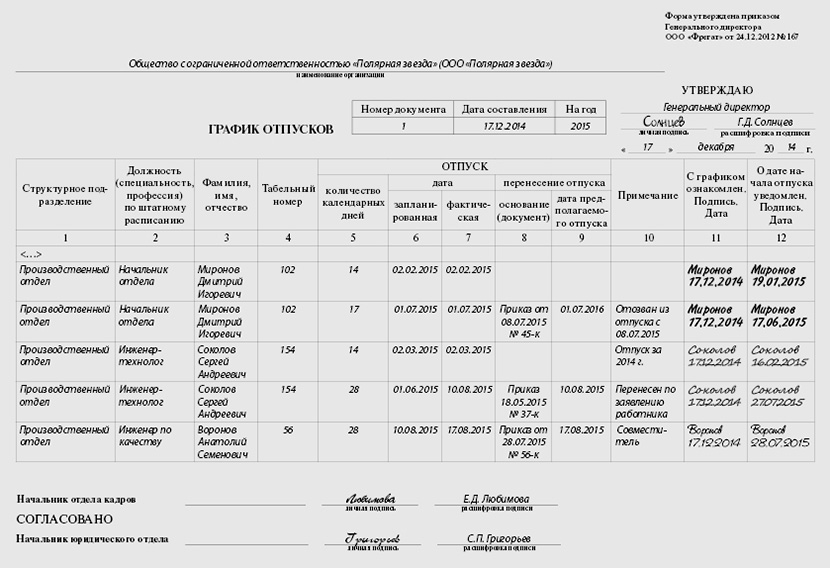
Maria Lapina

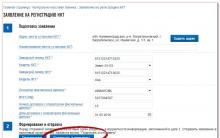
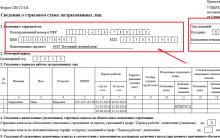

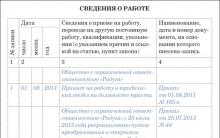
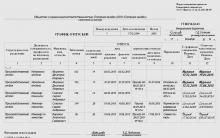





How to issue a power of attorney to represent the interests of an LLC to an individual?
How to apply for an IP: step by step instructions
Form of power of attorney to receive goods or material assets
The deadline for registering an individual entrepreneur in the tax
Business plan for a law firm: an example with calculations legal support for a business